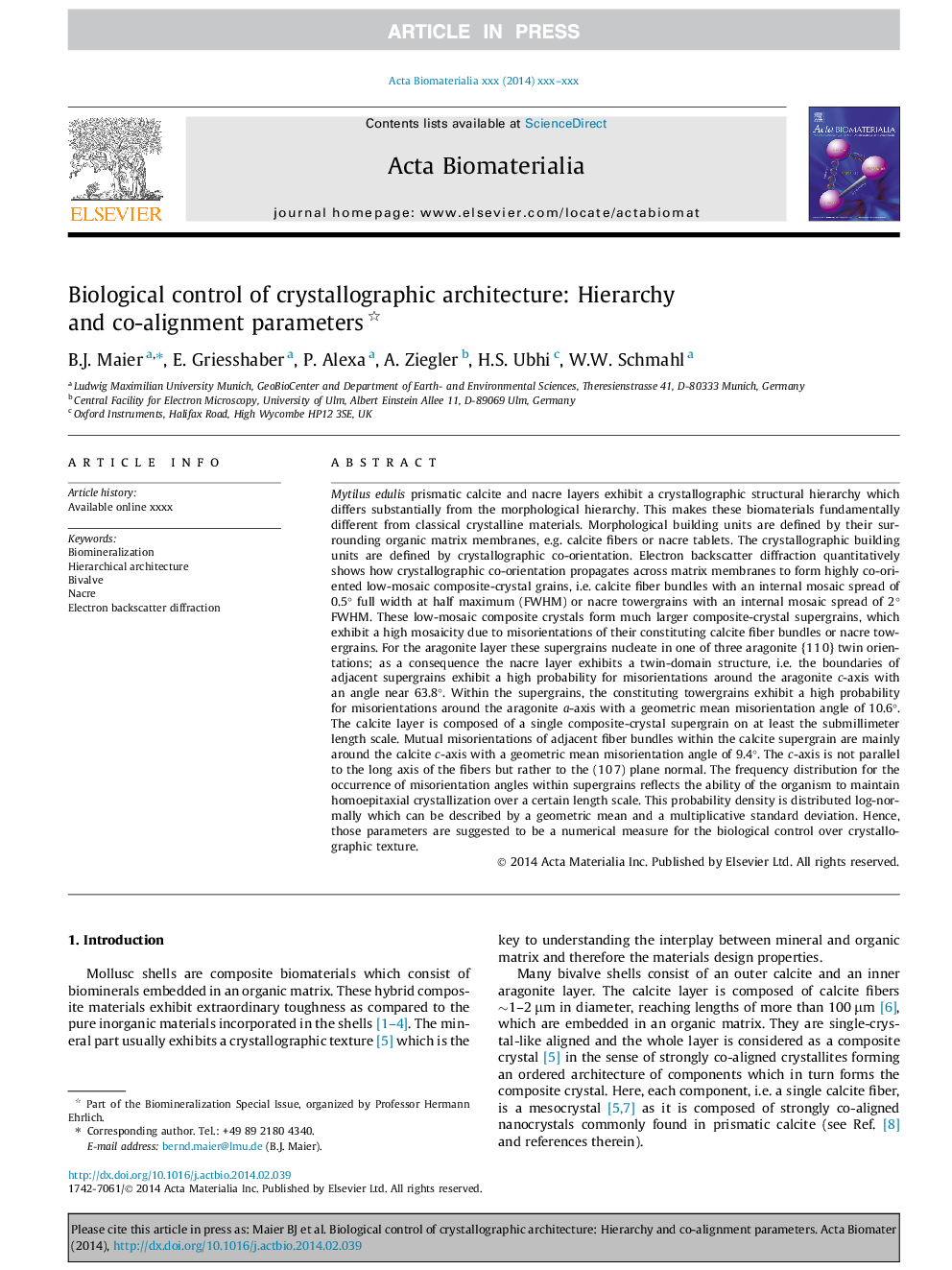| کد مقاله | کد نشریه | سال انتشار | مقاله انگلیسی | نسخه تمام متن |
|---|---|---|---|---|
| 6482073 | 43 | 2014 | 9 صفحه PDF | دانلود رایگان |
عنوان انگلیسی مقاله ISI
Biological control of crystallographic architecture: Hierarchy and co-alignment parameters
ترجمه فارسی عنوان
کنترل بیولوژیکی معماری کریستالوگرافی: پارامترهای سلسله مراتبی و هماهنگی
دانلود مقاله + سفارش ترجمه
دانلود مقاله ISI انگلیسی
رایگان برای ایرانیان
کلمات کلیدی
بیومنریالیزاسیون، معماری سلسله مراتبی، دوشیزه نارر، پراش پرتو الکترونی،
موضوعات مرتبط
مهندسی و علوم پایه
مهندسی شیمی
بیو مهندسی (مهندسی زیستی)
چکیده انگلیسی
Mytilus edulis prismatic calcite and nacre layers exhibit a crystallographic structural hierarchy which differs substantially from the morphological hierarchy. This makes these biomaterials fundamentally different from classical crystalline materials. Morphological building units are defined by their surrounding organic matrix membranes, e.g. calcite fibers or nacre tablets. The crystallographic building units are defined by crystallographic co-orientation. Electron backscatter diffraction quantitatively shows how crystallographic co-orientation propagates across matrix membranes to form highly co-oriented low-mosaic composite-crystal grains, i.e. calcite fiber bundles with an internal mosaic spread of 0.5° full width at half maximum (FWHM) or nacre towergrains with an internal mosaic spread of 2° FWHM. These low-mosaic composite crystals form much larger composite-crystal supergrains, which exhibit a high mosaicity due to misorientations of their constituting calcite fiber bundles or nacre towergrains. For the aragonite layer these supergrains nucleate in one of three aragonite {1 1 0} twin orientations; as a consequence the nacre layer exhibits a twin-domain structure, i.e. the boundaries of adjacent supergrains exhibit a high probability for misorientations around the aragonite c-axis with an angle near 63.8°. Within the supergrains, the constituting towergrains exhibit a high probability for misorientations around the aragonite a-axis with a geometric mean misorientation angle of 10.6°. The calcite layer is composed of a single composite-crystal supergrain on at least the submillimeter length scale. Mutual misorientations of adjacent fiber bundles within the calcite supergrain are mainly around the calcite c-axis with a geometric mean misorientation angle of 9.4°. The c-axis is not parallel to the long axis of the fibers but rather to the (1 0 7) plane normal. The frequency distribution for the occurrence of misorientation angles within supergrains reflects the ability of the organism to maintain homoepitaxial crystallization over a certain length scale. This probability density is distributed log-normally which can be described by a geometric mean and a multiplicative standard deviation. Hence, those parameters are suggested to be a numerical measure for the biological control over crystallographic texture.
ناشر
Database: Elsevier - ScienceDirect (ساینس دایرکت)
Journal: Acta Biomaterialia - Volume 10, Issue 9, September 2014, Pages 3866-3874
Journal: Acta Biomaterialia - Volume 10, Issue 9, September 2014, Pages 3866-3874
نویسندگان
B.J. Maier, E. Griesshaber, P. Alexa, A. Ziegler, H.S. Ubhi, W.W. Schmahl,
